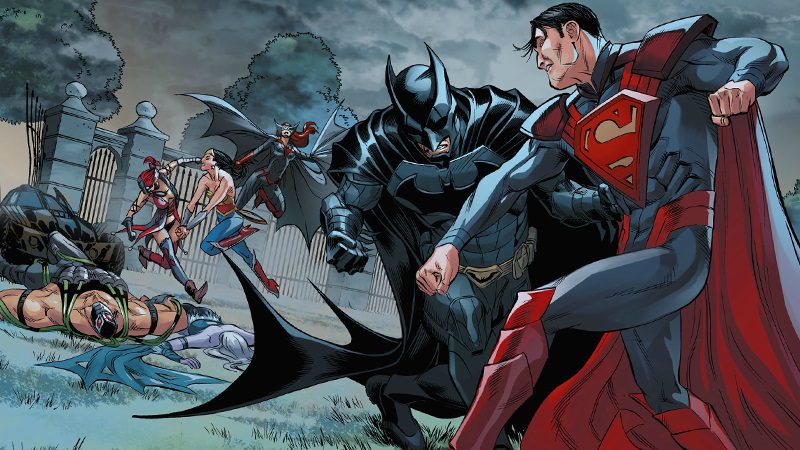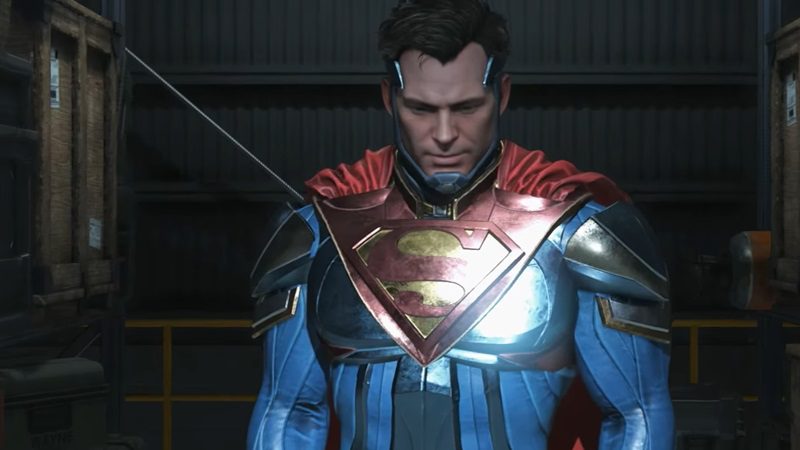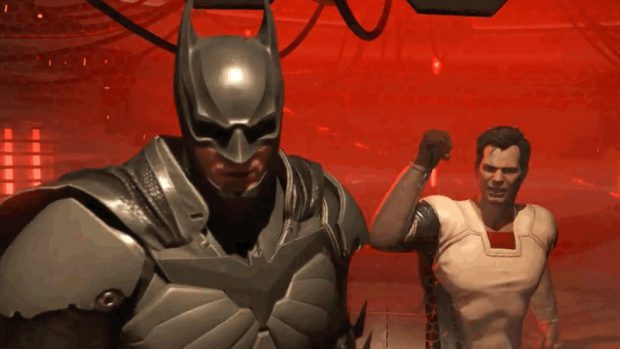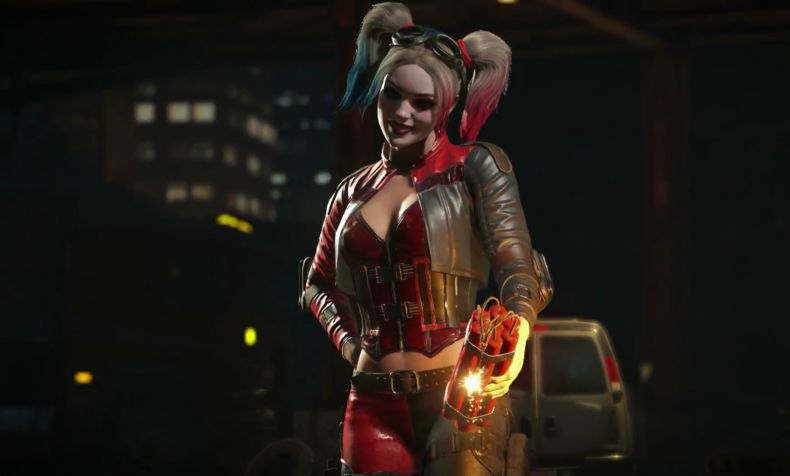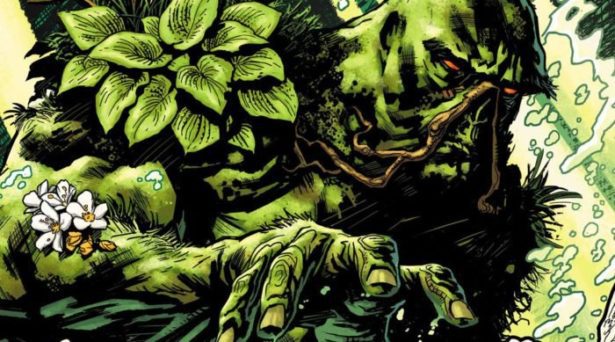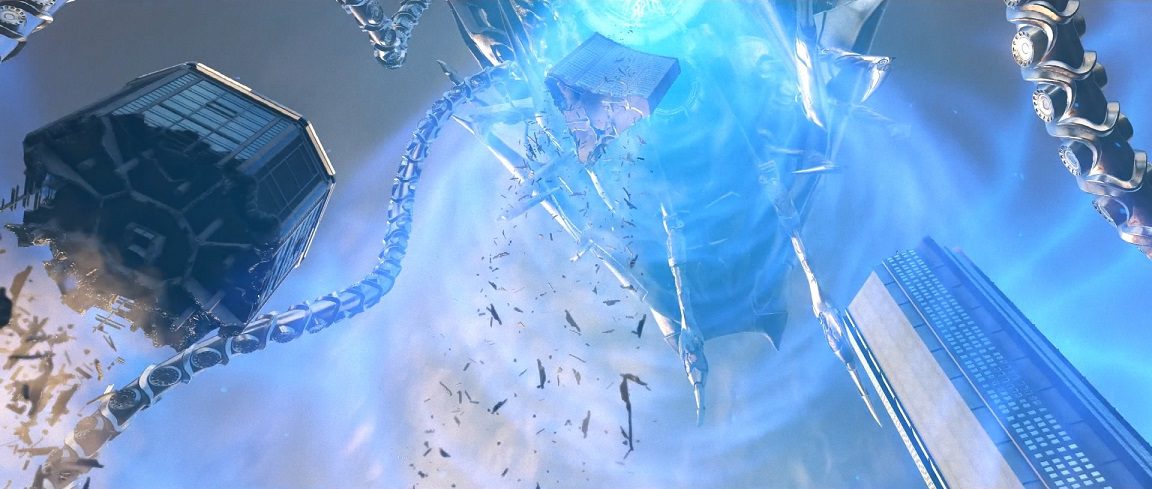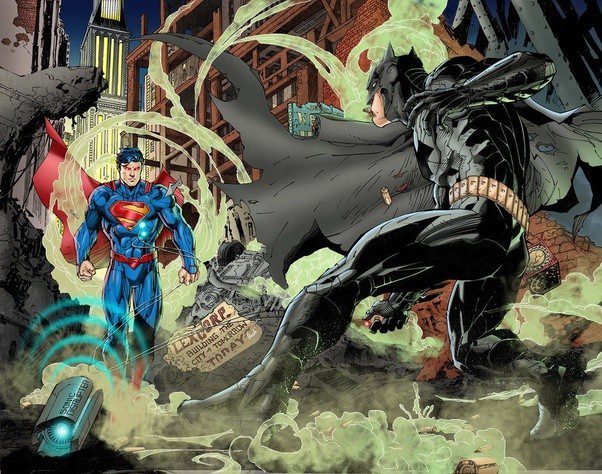A Beautifully Rendered, Masterfully Voice Acted, Poorly Written Mess.
As I stated in my review of the game, Injustice 2, though easy on the eyes and ears, the game’s story was a letdown. Since then, I have played the story through three more times, going through all branching paths and playing both Batman and Superman’s ending each time, and I have revised my assessment. The game’s story isn’t just a letdown; this is a story that doesn’t deserve DC Comics logo stamped on it. Some of these criticisms may sound nitpicky, but there is a lot here that, as a comic book fan, I can’t ignore. Before I begin, let me repeat what I said in my review; Injustice 2 is a solid fighting game with great graphics. The issue is that the story is well below the standard NetherRealm Studios has set with previous games, including the first Injustice game. Be warned, SPOILERS AHEAD.
5. The Premise of Injustice Itself
This wasn’t as big an issue for me in the past game as the main focus of the story was not the battle between the Batman’s Insurgency and Superman’s Regime, but the Justice League members who were pulled into the alternate universe. The superhero conflict just provides the setting in which to tell a multiverse story. The best moments were the interactions between the characters of different realities, especially the confrontation between the mainstream continuity’s Superman and the Regime’s Superman. These were moments that helped the audience better understand our favorite heroes as they were confronted by their twisted doppelgangers. The issues begin when this alternate universe is made to stand on its own.
Even with the tie-in comics released to better explain the events prior to the first game, there is a lot that isn’t explained and more that the audience is simply supposed to just accept. How did Joker learn of Superman’s identity and his relationship with Lois? How did Joker know how to combine Scarecrow’s fear gas with kryptonite? How did Joker know how to perform the surgery that connected an arming device to Lois’ heart? How did Joker get a hold of a nuclear submarine armed with nuclear weapons? How did Joker get one of those nuclear weapons into Metropolis? Where was Batman when his arch nemesis was doing all this? Anyone who knows the Dark Knight knows that he is always keeping tabs on Gotham’s villains, especially the Joker. We’re also supposed to believe that Lois couldn’t be brought to one of Ra’s al Ghul’s Lazarus Pits and brought back to life. None of this makes sense to anyone who knows DC Comics. This, however, is just the first few issues of the Injustice comic.
I could write an entire article on why the path from Superman the hero to Superman the dictator of Earth makes little sense. Characters behave out of character, even in the context of the story. When the American government targeted Superman, abducting his parents to keep him from saving innocent lives, no one, not even Batman should have been siding against him. Even villains like Captain Cold, who are against the taking of innocent lives, would have joined Superman’s cause. Even under a cursory examination, Injustice falls apart. It could be that the premise of the story was too enticing not to explore, but that is why more effort should have been taken to convince the readers that it was even possible.
4. Characters Out of Character
As I stated in my review and earlier in this analysis, comic book fans are expected to just accept the bizarre behavior of their favorite characters. Even in the context of the Injustice story, the way they act makes little sense. There are three characters whose bizarre behavior really stands out from the rest, Doctor Fate, Superman, and Batman. Both Kent Nelson and the spirit of Nabu, a Lord of Order, are usually at odds with each other, but nothing either does in this game makes sense. Why did Doctor Fate save Black Canary from Superman’s Regime? Why were she and Green Arrow, who comes from an alternate Earth, brought to this one? Why does Nabu side with Brainiac and not Superman, considering the former brings death and chaos while the latter brought tyrannical order? Why doesn’t Kent himself try to stop this? The only way any of this would make sense is that Doctor Fate was set up as the real villain of the story and he knew, being able to see the future, that Black Canary and Green Arrow would be the ones to stop him.
Superman’s behavior could be best described as bipolar. In one moment, we see a hero willing to sacrifice himself to save the billions of aliens imprisoned on Brainiac’s ship, and in the next, he plots his domination of not only Earth but other Earths within the greater multiverse. Superman shows real emotion when meeting Supergirl for the first time, elated at the fact that, after losing Lois and his unborn child, there is still one member of his family that’s alive. He later shows deep concern for Supergirl’s safety when she is knocked unconscious by Brainiac’s ship, and later kidnapped by the genocidal alien. All of this character development is thrown out the window when Supergirl doesn’t want to kill Brainiac, even after she witnessed her mother murdered by his robots. Instead of trying to do right by his cousin and uphold the traditions of the House of El, Superman becomes a two-dimensional cartoon villain bent on world domination. What was the point of having any of the interactions between him and Supergirl, as well as his interactions with Batman if this was not meant to be a redemption story?
Batman’s behavior, even in the context of this story, is utterly bizarre, especially his feelings towards his former friends in the Regime, notably Superman. It is made clear throughout the game’s story that he laments not being able to prevent Superman from becoming a tyrant. His conversation with Supergirl following Superman’s apparent death at the hands of Brainiac further emphasizes this point. After Brainiac’s defeat, Batman is put in a position similar to the one he was in years ago. Instead of trying to reason with Superman, to keep him from making another mistake, Batman pulls out a gold kryptonite knife and slashes him across the chest. This instantly escalates into the final battle between those who want Brainiac dead and those who do not. The action makes little sense if players are to believe his previous statements to Supergirl. Even more puzzling is that, during the ‘Absolute Justice’ story ending, Batman laments his inability to save his friend despite making no real effort to do so. How are players supposed to believe Batman after watching him try to knife Superman? This, however, is just a small portion of the story’s Batman-related issues.
3. Batman’s Bizarre Sense of Morality
In the comics, Batman began as a gun wielding vigilante. The formation of the Comic Code Authority (CCA) in 1954 put an end to this version of the Dark Knight, as it banned graphic depictions of violence in comic books. Superheroes weren’t allowed to be depicted acting in what was deemed an unethical manner. Despite the CCA being abandoned by DC Comics in 2011, Batman has not reverted to his pre-CCA depiction and has instead maintained the moral code set out by this governing body. The Dark Knight continues to operate by a policy of not taking lives, no matter how dangerous the villain is. Considering that even law enforcement is forced to take lives to protect innocent people, this makes no sense, especially in the context of the game’s events. Batman is not fighting street crime anymore; he’s fighting a war, first against Superman’s Regime, second against Brainiac and Gorilla Grodd’s Society. How do you fight such a war if you’re not willing to take lives? Who he chooses to fight that war with also raises issues.
Considering how much disdain Batman has toward former Regime members, why is partnered with Harley Quinn? If Superman and Wonder Woman are irredeemable for their actions as leaders of the Regime, why isn’t she? She helped Joker blow up Metropolis, murdering millions, far more than Superman’s Regime did. Later, as a member of Batman’s Insurgency, she kills Lobo. His partnership with Black Canary is also questionable, considering she shot Superman with a kryptonite bullet previously, and would likely do it again given the chance. Then there’s Green Arrow, who seemingly kills a number of nameless goons at the end game’s second chapter with an exploding arrow, as well as Swamp Thing, a possible ally for Batman’s cause who will kill anyone who threatens nature, including shady businessmen whose only crime is polluting. Where is the consistency in this moral code? If Batman’s own son, Damian, is irredeemable for killing Victor Zsasz, a man who admits to killing one-hundred-and-twenty-one women, why aren’t they?
It can’t be that the writers don’t understand how nonsensical this code of conduct is. Damian even points it out in the first chapter, noting the hypocrisy in Batman’s actions, that he is willing to cause traumatic brain injuries but stops short of killing. Considering that this code of conduct is the central issue in Batman’s conflict with Superman over the killing of dangerous criminals, it should at least be consistent. Neither Batman nor those allied with him seem to strictly adhere to it, bending the code, if not breaking it outright on a whim. If Batman and the others were so morally flexible, why are they at odds with Superman and the Regime to begin with?
2. Brainiac Downloader of Worlds
Players are introduced to Brainiac at the beginning of the game. His attack on Argo City is a horrifying spectacle, as his army of Beta robots murder helpless citizens. As Supergirl manages to escape the ruins of the once great Kryptonian city, Brainiac’s Skull Ship extracts the remains by downloading them. A change in Brainiac’s methods from shrinking and bottling to downloading might not seem important, and the writers may have thought they were being creative, but this small change creates a number of plot holes. The first is that the Bottle City of Kandor is visible and intractable in the Fortress of Solitude in the original game. This would also mean that Superman has fought Brainiac before and rescued the city from the alien’s collection. A serious oversight considering that the story relies on this being Brainiac’s first encounter with Earth and Superman.
The second is how exactly does Brainiac turn matter into data? This point may sound like I’m nitpicking, but changing the size of matter is something that has been well documented in DC Comics. The Atom, for example, can change his size, along with the density of his atomic structure with the assistance of a high-tech suit. How does this matter to data transformation work exactly? The game doesn’t explain it, nor it is explained how cities are destroyed through this process are reformed in perfect condition within Brainiac’s ship. Also, since cities are no longer bottled but downloaded to his ship, how is Supergirl able to hear those trapped by Brainiac? How are they even alive after being torn apart by the downloading process? On that point, how did Superman survive being hit by the ship’s beams? Why wasn’t he downloaded? If he was, how is it that he escaped when no other prisoner from the millions of worlds Brainiac attacked has? Again, as with far too much in this game’s story, none of this is explained.
The problem here is that the story is almost entirely focused on Brainiac, his Skull Ship and his capturing of cities, with very little explained. Even a few lines of dialogue from Cyborg, Professor Stein or Brainiac himself explaining the matter to data process would have sufficed. The lack of an explanation for any of this could be because the writers are ignorant about Brainiac. This would explain why Superman’s story ending, with him taking control of the Skull Ship, makes no sense. Do the writers not know that Brainiac has essentially turned himself into a cyborg and that through his cybernetic implants he controls his ship? Dominic Cianciolo and Jon Greenberg should have read Geoff Johns’ Superman: Brainiac story arc or watched Superman: Unbound, the DC Animated movie based on it, before writing Injustice 2.
1. Powered Versus Powerless
The idea that Batman could fight and defeat Superman was made popular by Frank Miller’s Batman: The Dark Knight Returns. Scans of their fight passed around as proof on online forums that this is possible, ignoring the context in which this fight took place as well as Superman’s state of mind and his greatly reduced power levels. This fight was repeated in Batman v. Superman: Dawn of Justice where the Dark Knight, aided by a fair amount of Kryptonite gas and his opponent’s unwillingness to fight, beat the Man of Steel. The problem with the idea that Batman could beat a metahuman as strong as Superman is that comic book canon makes it clear that it isn’t actually possible, at least not without some abnormal circumstances. In the Batman: Hush story arc, Batman himself states that if Superman wanted to kill him, he could do so easily, but that even under mind control, he’s holding back. The question is then under what circumstances could fight like this happen.
The first Injustice handled this question fairly well. The gap between the powered and powerless was closed through the use of Kryptonian nanomachines, which not only makes people stronger but more physically resistant. It’s a convenient plot device to allow characters like Batman to stand up to those like Superman. It doesn’t, however, level the playing field. Even with the Kryptonian nanomachines, Insurgency Batman still needed a Kryptonite weapon he had hidden in his Batcave to weaken Regime Superman. When the weapon is destroyed in a fight with Black Adam, the mainstream continuity’s Superman is brought to the alternate universe to end his twisted doppelganger’s reign. It is quite clear to the players that there are limits to what even Batman can do. The problem is that the Injustice 2 throws all of this out the window within the first few minutes.
In the game’s opening chapter, Batman, and Robin race to Arkham Asylum to prevent Superman from executing its worst inmates. The events take place before the establishment of the Regime and the creation of the Kryptonian nanomachines. Understanding that, there is no possible way that Batman could beat Cyborg, Wonder Woman and Superman in a fight. Even assuming the Red Solar Grenade he brought could weaken Superman to the point where he could be beaten, how does Batman fight Cyborg, let alone Wonder Woman? Injustice 2’s story is filled with these impossible matchups and the players are just expected to accept them. If Batman was this capable at fighting metahumans like Superman and Wonder Woman, why did he need the help of the mainstream continuity’s Justice League, especially their Superman? It all flies in the face of what was clearly established in the previous game.
As long as this list is already, there is a lot more I could have discussed. For example, Batman replacing Superman’s overt Regime with a covert one, using Brother Eye to monitor every communication device and satellite, and how that could be far more sinister. It’s not just utterly Orwellian, but comic book readers know what happens with Brother Eye, and it’s far worse than a tyrannical Superman (read Countdown to Infinite Crisis and the OMAC Project). This is the real issue with Injustice 2’s story. When the original game was released, it was at a time when too many DC Comics stories were written by writers not familiar with characters they were writing. During this era of mediocre writing came Injustice: Gods Among Us, providing comic book fans a story that was more in line with what they wanted. Fast forward a few years and we are seeing the opposite. If you’re looking for a good story, go read the latest issue of Superman: Rebirth or Super-Sons. They are both far better than what you’ll find here.

